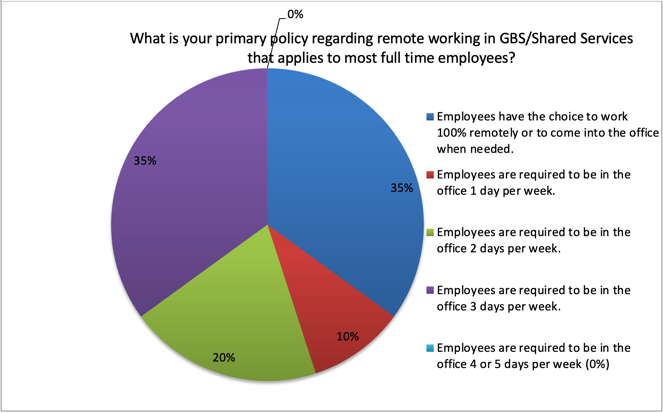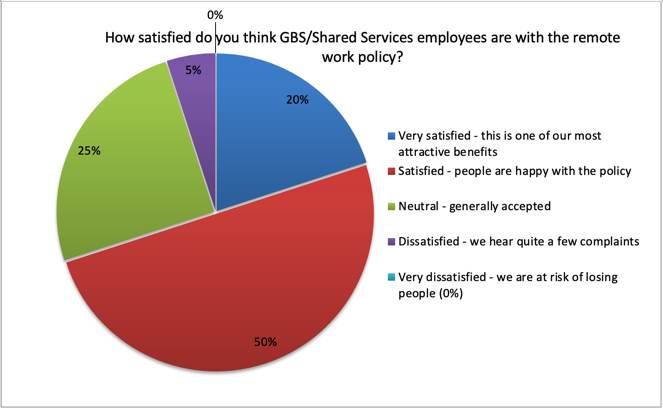Flexible Work Arrangements in Shared Services in March 2025
Introduction
Five years ago, the impacts of the global COVID-19 pandemic were immediate for everyone, with a dramatic and rapid shift to shutter Shared Services offices as much as possible, with work activities taking place remotely, and most often from employee’s homes, to ensure social distancing and reduce the spread of the virus. As previously reported in other articles, the ability of Peeriosity member companies to respond quickly with little to no negative impact to quality or efficiency was impressive overall.
The question at play for many was what happens next? Once the requirements to work from home go away as the virus concerns are eliminated, what happens to the flexible work arrangements that were put in place as a result of the pandemic?
Fast forward to today – March 2025. Flexibility in working arrangements since COVID has become an expectation for many employees and companies have taken different paths with respect to getting employees back to the office – or not. How does your companies approach for Shared Services/GBS work arrangements compare with others, and how happy are your employees with your current remote work policy?
Fortunately, for Peeriosity members, it’s easy to draft a polling question and instantly find out how other members tackle the problem, with the ability to directly follow up with other participants for further discussion and dialogue. Plus, the exchange is completely private, with only Peeriosity members from companies participating in the poll able to access the detailed results and findings.
Polling Results Review
Recently a Peeriosity poll was created to better understand the approach member companies are using regarding their current policy for remote working and how happy Shared Services/GBS employees are with the policy.
Regarding the question for the current policy for remote working, while no company reported a requirement for 4 or 5 days in the office, the distribution was bimodal, with 35% where employees are permitted to work 100% remotely or come into the office when needed, and an additional 35% where employees are required to be in the office 3 days per week. The other 30% falls between these two options, with 10% requiring employees to be in the office 1 day per week, and 20% requiring employees to be in the office 2 days per week.

Regarding the question about employee satisfaction with the current remote policy, 20% indicated employees were very satisfied, and another 50% indicated that employees were satisfied. The remaining 30% included 25% who indicated a neutral response and 5% indicating employees were dissatisfied. The design of Peeriosity-100 polls allows you to “mouse over” a response for one poll and see the distribution for how companies selecting that response answered the other poll question. Not surprising, greater levels of satisfaction were directly correlated to the amount of flexibility employees have to work from home.

Here are some of the comments from responding companies:
- It is a hybrid work model; employees are encouraged to attend between 1 to 3 times a week or come to the office when needed; I would say that people are satisfied with the policy.
- 1 day a week is what we are trying to push through.
- The policy varies slightly by country, with some locations requiring 3+, others 4; however, the bulk of the population must be in office a minimum a 2 days per week.
- Due to the size of our Shared Services team, we are exempted from hybrid schedule (3 days in office). Most teams are 100% remote, and we have “hotel” desks that are first-come-first serve but shared across HQ teams. We do have some associates that prefer to work in office, and we do allow that as long as we have space available to assign permanent desk assignments.
Closing Summary
While an aggressive move to Flexible Work Arrangements was requirement for doing business for several years beginning in early 2020, as companies implemented plans for a new post-pandemic normal, many companies are continuing with work arrangements that are significantly more flexible than work arrangements in place before the pandemic. Now, in early 2025, several years after the pandemic ended, there appears to be a split between companies who are very flexible, with full time work from home possible, and companies who are requiring employees to work from the office 3 day a week.
What decision did your company make regarding where Shared Services/GBS work is be performed? Is your policy global, or are there differences depending on the geographic region? If you are requiring more days in the office, what has been the impact of productivity and employee satisfaction?
Who are your peers and how are you collaborating with them?
____________________________________________________________________________
Polling is available exclusively to Peeriosity-100 member company employees, with consultants or vendors prohibited from participating or accessing content. Members have full visibility to all respondents and their comments. Using Peeriosity-100’s integrated email system, Peer Mail, members can easily communicate at any time with others who participated in Polling.

